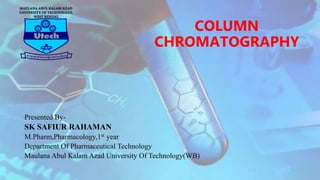
column chromatography.pptx
- 1. COLUMN CHROMATOGRAPHY Presented By- SK SAFIUR RAHAMAN M.Pharm,Pharmacology,1st year Department Of Pharmaceutical Technology Maulana Abul Kalam Azad University Of Technology(WB)
- 2. CONTENTS • Introduction • Principle • Classification • Packing technique • Factors affecting column chromatography • Advantages • Disadvantages • Applications • Conclusions • References
- 3. Introduction • The word chromatography comes from Greek words “Chroma” means colour and “graphein” means write.so chromatography means ‘to write with colour’. • Chromatography is a physical method of separation of a mixture in which the mixture is dissolved in a fluid solvent called the mobile phase, which carries it through a system called the stationary phase. • There are a number of different kinds of chromatography, which differ in the mobile and the stationary phase used.
- 4. Mobile phase • Ideal properties: It acts as a solvent It acts as a developing agents It acts as an eluting agents Examples: Ethanol, Acetone, Water, Acetic acid, Pyridine, etc. • Different mobile phases used: Ex: In increasing order of polarity or elution strength. Cyclohexane < carbon disulphide < ether < Benzene < toluene <ester < alcohol < chloroform < acetone < water < pyridine <organic acids.
- 5. Stationary phase • Ideal properties: High mechanical stability and chemically inert. Particle should have uniform shape and size(60-200 microns). It should be colourless, inexpensive and readily available. It Should allow free flow of mobile phase. It should be suitable for the separation of mixtures of various compounds. • Ex: In increasing order of adsorbing strength- sucrose < starch < inulin < talc < calcium carbonate < calcium phosphate < magnesia < silica gel < magnesium silicate < alumina < charcoal.
- 6. Principle • When a mixture of components dissolved in the mobile phase is introduced into the column, the individual components move with different rates depending upon their relative affinities. • Which components have lesser affinity towards stationary phase moves faster and eluted out first. • The component which have greater affinity towards stationary phase moves slower down the column and eluted out latter. • The adsorption of solute molecules to the column occurs in a reversible manner. Fig: 1 Ref: https://www.sciencedirect.com/topics/biochemistr y-genetics-and-molecular-biology/column- chromatography [Accessed on: 31.01.2023;16:30]
- 7. The rate of movement of component (R) is given by, R= Rate of movement of component Rate of movement of mobile phase When a liquid mobile phase is used, equation is written as R= Am/Am+ αAs Where α = Partition coefficient Am = Average cross section of mobile phase As = Average cross section of stationary phase
- 8. Classification These classifications are based upon stationary phase: Types of column chromatography Mobile phase Stationary phase Sample phase Adsorption Chromatography Liquid Solid adsorbent Solution Partition Chromatography Liquid Immiscible solvent on solid matrix Solution Ion exchange chromatography Liquid Ion exchange resin Solution Gel chromatography Liquid Solvent held in the interstices of a polymeric solvent Solution
- 9. Classification Its depending on how the solvent flows down the column: • Gravity column chromatography:- If the solvent is allowed to flow down the column by gravity. • Flash chromatography:- If the solvent is forced down the column by positive air pressure. Nitrogen and argon is used.
- 10. Packing techniques • There are two types of preparing the column: Dry packing: Adsorbent is packed in the column in fine dry powder form. Fill the solvent till equilibrium is reached. After filling tapping can be done to remove void spaces. Ref: https://www.sciencedirect.com/topics/agricultural-and- biological-sciences/column-chromatography [Accessed on 29.01.23;22:50] Wet packing: The slurry of adsorbent with the mobile phase is prepared and is poured into the column. Stationary phase settles uniformly and no crack and air bubbles present in the column of adsorbent.
- 11. Factors Affecting column efficiency Dimension of the column: column efficiency has been improved by increasing length/width ratio of the column. Particle size of column packing: separation to be improved by decreasing the particle size of the adsorbent. Temperature of the column: the speed of the elution increases at higher temperatures. Quality of solvents: solvents having low viscosities is giving better results.
- 12. Advantages: • Any type of mixture can be separated by column chromatography. • Any quantity of mixture can also be. • Wider choice of mobile phase. Disadvantages: • Time consuming method. • More amount of solvent are required which are expensive. • Drying and bubble presence are possible.
- 13. Applications • Separation of mixture of compound or purify natural compound mixtures like alkaloid, glycosides. • Crude drug extraction. • It is used for the separation of amino acid, proteins & carbohydrates. • Isolation and purification of vitamins and hormones. • Isolation of metabolites from biological fluids. • It is used for the estimation of drugs in formulations. • Examination of vegetable oil and pharmaceutical preparations.
- 14. Conclusions We conclude that column chromatography is an effective way of determining the components present in a compound such as a mixture of pigments as well as in identifying the type of amino acid present.
- 15. References • Yu Liu, Alec S. Lininger, Lauren N. McCaskey, Rachel M. Thomas. Separation of Fluorescent Protochlorophyllide from Green Pumpkin Seed Using Column Chromatography. Journal of Chemical Education 2023, 100 (1) , 312-315. • Knockaert, M. et al. Intracellular targets of cyclin-dependent kinase inhibitors: identification by affinity chromatography using immobilised inhibitors. Chem. Biol.2000, 7, 411–422. • Takeshi Tanaka, Yasuko Urabe, Takuya Hirakawa, and Hiromichi Kataura . Simultaneous Chirality and Enantiomer Separation of Metallic Single-Wall Carbon Nanotubes by Gel Column Chromatography. Analytical Chemistry 2015, 87 (18) , 9467-9472. • Huaping Li, Lili Zhou, Tao Wu. Sodium dodecyl benzene sulfonate for single-walled carbon nanotubes separation in gel chromatography. Diamond and Related Materials 2018, 88 , 189-192. • Davies, Don R.; Johnson, Todd M. J. Isolation of Three Components from Spearmint Oil: An Exercise in Column and Thin- Layer Chromatography. Chem. Educ. 2007, 84, 318. • Figure 1: https://www.sciencedirect.com/topics/biochemistry-genetics-and-molecular-biology/column- chromatography [Accessed on: 31.01.2023;16:30] • Figure 2: https://www.sciencedirect.com/topics/agricultural-and-biological-sciences/column- chromatography [Accessed on 29.01.2023;22:50]
- 16. Thank You